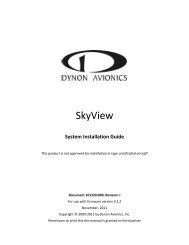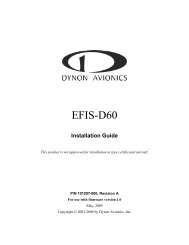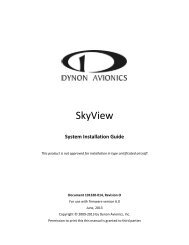EFIS-D100 Installation Guide - Dynon Avionics
EFIS-D100 Installation Guide - Dynon Avionics
EFIS-D100 Installation Guide - Dynon Avionics
Create successful ePaper yourself
Turn your PDF publications into a flip-book with our unique Google optimized e-Paper software.
Autopilot <strong>Installation</strong> and Configuration<br />
2 SERVO(S) FOUND PLEASE CENTER ALL CONTROL SURFACES AND MAKE SURE<br />
THEY HAVE A FREE RANGE OF MOTION. PRESS DISCONNECT SWITCH TO<br />
CONTINUE.<br />
Follow all onscreen instructions, moving the controls to each position, pressing the<br />
Disengage/CWS Button to confirm each position. This process calibrates the autopilot to<br />
detect the orientation and range of each servo.<br />
If calibration was successful:<br />
CALIBRATION WAS SUCCESSFUL. ROLL FOUND. PITCH FOUND. PRESS OK BELOW<br />
OR PRESS DISCONNECT SWITCH TO CONTINUE.<br />
Press the AP Disengage/CWS Button or OK button on the <strong>EFIS</strong>.<br />
If calibration was unsuccessful, an error message is displayed, describing the reason. The<br />
most common causes are not enough travel being detected, or too much travel. In either case,<br />
mechanical adjustments must be made.<br />
After successful completion of the calibration, the system automatically continues into SERVO<br />
TEST Mode. An initial SERVO TEST must be performed before the autopilot is usable. If the<br />
initial SERVO TEST is canceled, the AP status display at the lower left of the <strong>EFIS</strong> screen<br />
shows “TST” as the status for the installed servo(s).<br />
After successful calibration the screen displays:<br />
PLE ASE CENTER ALL CONTROL SURFACES AND MAKE SURE THEY HAVE A FREE<br />
RANGE OF MOTION. PRESS OK BELOW TO BEGIN THE TEST.<br />
Follow all onscreen instructions, moving the controls to each position, pressing the OK<br />
button to confirm each position. This process verifies that the controls move to the correct<br />
position, and ensures that the Disengage/CWS Button properly disengages the servos.<br />
Note: After successful completion of Configure<br />
DSAB, Servo Calibration, and Servo Test, the<br />
AP mode is enabled. The following occurs:<br />
The AP status indicator is displayed at the<br />
lower left of the <strong>EFIS</strong> screen (shown at<br />
right).<br />
The AP button is present on the <strong>EFIS</strong><br />
menu, replacing the BUGS menu (which<br />
is now located within the AP menu).<br />
All bugs (IAS, Heading, and Altitude) are turned hollow.<br />
With an autopilot installed, the heading and altitude bugs are<br />
only filled in when those modes are engaged (HDG, TRK,<br />
ALT hold).<br />
The <strong>EFIS</strong> now has a record of which servo performs which function and the particular range<br />
of motion it will be executing.<br />
If servos are swapped or replaced, Servo Calibration must be performed again.<br />
6-16 <strong>EFIS</strong>-<strong>D100</strong> <strong>Installation</strong> <strong>Guide</strong>
















